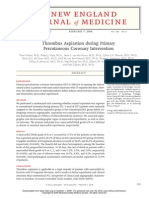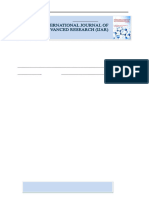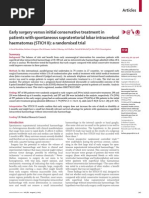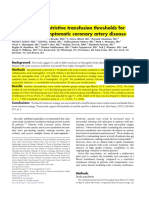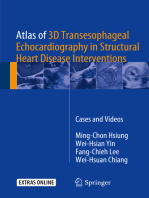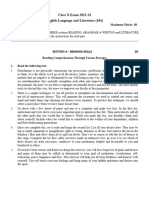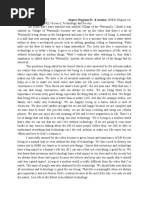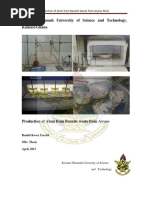Intracoronary Autologous CD34+ Stem Cell Therapy For Intractable Angina
Intracoronary Autologous CD34+ Stem Cell Therapy For Intractable Angina
Uploaded by
asep mahmudCopyright:
Available Formats
Intracoronary Autologous CD34+ Stem Cell Therapy For Intractable Angina
Intracoronary Autologous CD34+ Stem Cell Therapy For Intractable Angina
Uploaded by
asep mahmudOriginal Title
Copyright
Available Formats
Share this document
Did you find this document useful?
Is this content inappropriate?
Copyright:
Available Formats
Intracoronary Autologous CD34+ Stem Cell Therapy For Intractable Angina
Intracoronary Autologous CD34+ Stem Cell Therapy For Intractable Angina
Uploaded by
asep mahmudCopyright:
Available Formats
Original Research
Cardiology 2010;117:140–147 Received: May 24, 2010
Accepted after revision: July 28, 2010
DOI: 10.1159/000320217
Published online: October 23, 2010
Intracoronary Autologous CD34+ Stem
Cell Therapy for Intractable Angina
Shihong Wang Junyu Cui Wei Peng Min Lu
Department of Cardiovascular Medicine, General Hospital of Beijing Military Region of PLA, Beijing, China
Key Words for mechanical revascularization (percutaneous coronary in-
Myocardial ischemia ⴢ Bone marrow ⴢ Stem cells ⴢ tervention or coronary artery bypass grafting). Fifty-six pa-
Intracoronary infusion ⴢ Angiogenesis tients (27 women and 29 men aged 42–80 years) were en-
rolled in the treatment group, and 56 patients (28 women
and 28 men aged 43–80 years) who received optimal medi-
Abstract cal treatment and intracoronary saline injections were en-
Background/Objectives: A large number of patients with rolled in the placebo control group. Bone marrow was col-
coronary artery disease experience angina that is not suit- lected from all enrolled patients at a volume of 120–150 ml
able for revascularization and is refractory to conventional each in both groups. Selections of CD34+ cells were per-
medical therapy. Laboratory and preclinical studies have formed by a CE-marked device approved by the Security,
provided evidence for the safety and potential efficacy of Food and Drug Administration of China. Coronary angiogra-
autologous CD34+ stem cell therapies as treatment for an- phy had been performed before enrollment in this study.
gina. Clinical studies investigating intramyocardial trans- Results: No myocardial infarction was observed during in-
plantation of autologous CD34+ stem cells by catheter injec- tracoronary infusion. The intracoronary infusion of cells or
tion for patients with refractory angina show that this is safe saline did not result in cardiac enzyme elevation, cardiac per-
and feasible. It remains unclear whether intracoronary infu- foration or pericardial effusion. No arrhythmia, such as ven-
sion of CD34+ stem cells exerts beneficial effects in patients tricular tachycardia or ventricular fibrillation, was induced by
with angina as well. We addressed this question with a con- intracoronary infusion. No serious adverse events occurred
trolled clinical trial by enrolling 112 patients with refractory in either group. The reduction in the frequency of angina
angina. Previous trials have investigated the safety and ben- episodes per week 3 and 6 months after infusion was sig-
eficial effects of CD34+ cells isolated from granulocyte colo- nificantly higher in the treatment group (–14.6 8 4.8 at 3
ny-stimulating factor-mobilized peripheral blood; in our tri- months and –15.6 8 4.0 at 6 months) than in the control
al, we isolated CD34+ cells directly from the patient’s bone group (–4.5 8 0.3 and –3.0 8 1.2, respectively; p ! 0.01).
marrow. Methods: One hundred and twelve patients with Other efficacy parameters such as nitroglycerine usage, ex-
diffuse triple-vessel disease and Canadian Cardiovascular ercise time and the Canadian Cardiovascular Society class
Society class III or IV angina were enrolled in a double-blind, also showed an improvement in the treatment group com-
randomized (1: 1), placebo-controlled study. Patients re- pared to the control group. A significant improvement in
ceived optimal medical treatment but were not candidates myocardial perfusion was noted in the treatment group
© 2010 S. Karger AG, Basel Shihong Wang, MD
0008–6312/10/1172–0140$26.00/0 Department of Cardiovascular Medicine
Fax +41 61 306 12 34 General Hospital of Beijing Military Region of PLA
E-Mail karger@karger.ch Accessible online at: Nan Men Cang 5, Dongcheng District, Beijing 100700 (China)
www.karger.com www.karger.com/crd Tel. +86 10 6672 6929-8034, Fax +86 10 6672 1161, E-Mail Shihongw1 @ yahoo.com.cn
compared to the control group, as measured by single-pho- dotoxin content. Once cells passed the lot release criteria, the pa-
ton emission computed tomography. Conclusions: This ran- tients underwent coronary angiography and received an intracor-
onary infusion of CD34+ cells [suspended in saline plus human
domized trial investigating intracoronary infusion of autolo- serum albumin (HSA)] or cell diluents (saline plus HSA) using an
gous CD34+ cells in patients with intractable angina shows over-the-wire balloon guiding catheter (Cordis) [8]. Ten and 5 ml
the safety and feasibility of this therapy and provides evi- of cell suspension or placebo solution were infused separately into
dence for efficacy. Copyright © 2010 S. Karger AG, Basel the right coronary artery and the left main coronary artery. Pa-
tients were discharged from hospital several days after the infusion
procedure. Follow-up took place 1, 2 and 4 weeks and 3 and 6
months after the procedure. Single-photon emission computed to-
mography (SPECT) was performed at baseline and 6 months after
Introduction the procedure by a single technician who was unaware of the trial.
Despite improvement in perfusion by conventional Selection of Patients
Enrollment criteria included age over 30 years, diffuse triple-
antianginal medications and interventional revascular- vessel disease and functional Canadian Cardiovascular Society
ization, many patients with coronary artery disease con- (CCS) class III or IV angina. Patients were receiving convention-
tinue to have severe angina [1, 2]. It is estimated that 20– al medical therapy, including long-acting nitrates, maximal use
30% of patients with diffuse triple-vessel disease in China of -adrenergic blocking agents and calcium channel agents,
who have failed to respond to conventional medical ther- without control of their angina. Patients were required to be con-
sidered noncandidates for conventional revascularization by a
apies continue to experience angina. About 1,000–2,000 cardiologist. A cardiac surgeon had to have reviewed the most
new patients are hospitalized per year in the General recent (within 6 months) angiogram to verify ineligibility for sur-
Hospital of Beijing Military Region of PLA. Thus, there gical revascularization. Patients were also required to have isch-
is a strong medical need for the development of new ther- emia on nuclear perfusion imaging, to complete at least 1 min but
apies for this patient population. no more than 6 min of a standard Bruce protocol and to experi-
ence angina during the baseline exercise test. Patients were un-
A study by Losordo et al. [3] showed the efficacy of in- aware of which treatment they received.
tramyocardial transplantation of autologous granulocyte Key exclusion criteria included myocardial infarction within
colony-stimulating factor-mobilized peripheral blood 30 days of treatment; successful coronary revascularization with-
CD34+ stem cells for the treatment of angina. However, in 3 months of enrollment; documented transient ischemic attack
it had a potential to increase the risk of myocardial infarc- within 60 days of treatment; severe aortic stenosis or insufficien-
cy; severe mitral stenosis or severe mitral insufficiency; predomi-
tion and inconvenient NOGA-guided operations [3–5]. nant congestive heart failure symptoms; severe comorbidities as-
Laboratory and preclinical studies have provided evi- sociated with a reduction in life expectancy to less than 1 year;
dence for the safety and potential efficacy of intracoro- uncontrolled hypertension, and joint disease, peripheral vascular
nary autologous CD34+ stem cell infusion for cell regen- disease or chronic obstructive pulmonary disease that would lim-
eration following myocardial infarction [6, 7]. Accord- it walking on a treadmill.
ingly, we initiated a pilot, first-in-human study to evaluate Bone Marrow Collection and Stem Cell Selection
the safety, feasibility and bioactivity of intracoronary Bone marrow (120–150 ml) was aspirated from the posterior
transplantation of bone marrow CD34+ stem cells for in- iliac crest under local anesthesia by a doctor who was unaware
tractable angina. of the treatment. Bone marrow cells were then magnetically la-
beled with CliniMACS CD34 Reagent and separated using the
CliniMACS System (Miltenyi Biotec) in a procedure derived
from the manufacturer’s instructions. After elution from the in-
Patients and Methods strument, CD34+ cells were spun down and resuspended in 15
ml of saline plus HSA by a technician who was unaware of the
Study Design treatment.
This was a randomized, placebo-controlled clinical trial (reg-
istered to the Health Department of PLA, People’s Republic of Chi- Bone Marrow Stem Cell Infusion
na). One hundred and twelve patients were enrolled in the study The equipment we used for infusing intracoronary stem cells
and divided between the CD34+ cell treatment and placebo con- and placebo was the GE Innova 2000 DSA. The amount of hepa-
trol groups. The patients and researchers were unaware of the rin used was 3,000 IU. Approximately 1–2 h after the completion
treatments. All patients underwent bone marrow collection. The of the CD34+ cell separation, 10 ml of cells and 5 ml of saline were
CD34+ cell fraction was purified using a commercially available infused into the proximal left main coronary artery and right cor-
device (CliniMACS쏐 System, Miltenyi Biotec, Bergisch Gladbach, onary artery separately by an over-the-wire balloon. The balloon
Germany) according to the manufacturer’s instructions. Cells was inflated to a 1:1 diameter ratio, the guide wire was removed
were then subjected to testing and were required to meet lot release and 2 ml of the specimen was infused at 1 ml/min. The balloon
criteria, which included sterility, viability and the absence of en- was then deflated and the vessel reperfused for 2 min. The balloon
CD34+ Stem Cell Therapy for Intractable Cardiology 2010;117:140–147 141
Angina
was then reinflated and the process repeated until the entire 15- 1-mm ST segment depression in the case of an isoelectric or ele-
ml dose was delivered. The mean number of CD34+ cells infused vated ST segment at rest and as the time to a depression of greater
was 5.6 8 2.3 ! 107 (all cells sorted from the bone marrow spec- than 1 mm in the case of ST depression at rest. During this study,
imen and checked by flow cytometry). The percent viability of the if neither a 1-mm ST segment depression nor angina occurred
stem cells was 94–96%. during the ETT, the total exercise duration was used as the mea-
sure of time to 1-mm ST segment depression and time to onset of
End Points angina.
Safety ETT and ECG tracings were analyzed centrally at a reading
An independent data safety monitoring board reviewed safety center by cardiologists blinded to treatment allocation. When
data in a timely manner. In addition to routine physical examina- reading the 2- and 4-month ETT tracings during the study period,
tion and laboratory testing, patients were also monitored with the cardiologist did not have access to previous ETT data.
ECG, transthoracic echocardiography and thoracic X-ray at regu-
lar intervals. Echocardiography was performed immediately after CCS Class
the infusion procedure and before hospital discharge in all sub- The CCS class was defined according to the CCS Functional
jects. Classification as follows. Class I: ordinary physical activity, such
as walking and climbing stairs, which does not cause angina. An-
Arrhythmia Monitoring gina with strenuous, rapid or prolonged exertion at work or rec-
A 24-hour Holter monitoring was required by all patients be- reation. Class II: slight limitation of ordinary activity. Walking or
fore infusion and 1 week and 3, 6 and 12 months after infusion. climbing stairs rapidly, walking uphill, walking or stair climbing
after meals, in cold, in wind, under emotional stress or only dur-
Efficacy ing the few hours after waking up. Walking more than two blocks
Bioactivity was assessed according to the parameters dis- on the level and climbing more than one flight of ordinary stairs
cussed in the following sections. at a normal pace and in normal conditions. Class III: marked lim-
itation of ordinary physical activity. Walking one to two level
Angina Frequency blocks and climbing more than one flight of stairs in normal con-
The frequency of angina per week in both the groups was as- ditions. Class IV: inability to carry out any physical activity with-
sessed by a colleague (Xuan Zhang) who was unaware of the treat- out discomfort; anginal syndromes may be present at rest. The
ment in detail. Patient outcomes were confirmed by patient re- CCS class was assessed by a single technician who was unaware
ports during the study period both inside and outside the hospital. of the treatment.
Nitroglycerine Use SPECT Perfusion Imaging
Nitroglycerine (NTG) use per week in both the groups was as- For 201-thallium SPECT, patients performed a symptom-lim-
sessed by Xuan Zhang. Researchers were unaware of the treat- ited bicycle ergometer exercise test with continuous monitoring
ment in detail, and drug distribution was confirmed by patient and a 12-lead ECG recording for each minute of exercise. At near-
reports during the study period both inside and outside the hos- maximal exercise, 201-thallium was injected intravenously and
pital. exercise was continued for 1 min after injection. Patients were im-
aged in the supine position beginning 10 min after exercise. Rest-
Exercise Tolerance ing images were acquired 3–4 h later. Semiquantitative visual
Symptom-limited treadmill exercise tolerance tests (ETTs), interpretation of SPECT perfusion images used short-axis and
using the standard Bruce protocol (Case 8000, Marquette Elec- vertical long-axis tomograms. Each patient was assessed by a
tronics Inc., Fla., USA), were performed in the morning and at consensus of two expert observers (who were unaware of the
approximately the same time of day at each visit. Time to onset of treatment) using percent perfusion of the defective area. The sum
angina and time to limiting angina during the ETT were deter- of the differences between the stress and resting values of each
mined by the investigator, whereas total exercise duration and patient was calculated.
time to 1-mm ST segment depressions were determined by central
reading. Heart rate was obtained from the ECG recording and a Statistical Analysis
rate-pressure product (heart rate – systolic blood pressure). Since this was a first-in-human study, no prior data were avail-
During the run-in period, ETTs were considered positive if able on which to base power calculations. Accordingly, results are
they were stopped secondary to the occurrence of limiting angina presented as changes from baseline to follow-up in patients as-
pectoris and accompanied by at least 1 mm of ST segment depres- signed to placebo versus those assigned to cell infusion. A statisti-
sion with 1–6 min of exercise. During the study period (i.e. at cal assessment of efficacy was performed, and certain parameters
months 2 and 4), ETT could continue beyond 6 min or stop before revealed significant improvement. Because the crossover of pla-
1 min. Stopping criteria included limiting angina pectoris, dys- cebo-assigned patients was permitted after 6 months, the analysis
pnea and extreme fatigue. The ST segment was measured 80 ms of efficacy parameters is restricted to 6 months after the initial
after the J point in 3 consecutive QRS complexes with a flat base- treatment assignment. All values are expressed as means 8 SE.
line. If ST segment depression was present at rest, the change was Paired Student’s t tests were performed for comparison of the data
calculated from the value at rest to the value during exercise. If ST before and after treatment. Comparisons between the 2 groups
segment elevation was present at rest, ST depression during exer- were made using one-way analysis of variance. A probability val-
cise was calculated from the ECG isoelectric line. Thus, the time ue !0.05 was considered to denote statistical significance.
to 1-mm ST segment depression was calculated as the time to
142 Cardiology 2010;117:140–147 Wang/Cui/Peng/Lu
In compliance with the ‘Administrative Regulations on Medi- Table 1. Baseline characteristics according to treatment group
cal Institutions’ (State Council of the People’s Republic of China,
1994.09.01), all patients gave their informed consent and the study Placebo CD34+ cells p
protocol was approved by the ethical committee on human re- (n = 56) (n = 56)
search of the General Hospital of Beijing Military Region of PLA.
The authors had full access to the data and take full responsibil- Hyperlipidemia 32 (57) 31 (55) >0.05
ity for its integrity. Hypertension 24 (43) 22 (39) >0.05
Smoking history 12 (21) 11 (20) >0.05
Congestive heart failure 3 (5) 4 (7) >0.05
Myocardial infarction 6 (11) 5 (9) >0.05
Results Peripheral vascular disease 10 (18) 11 (20) >0.05
Diabetes mellitus 23 (50) 25 (45) >0.05
Patients ACE inhibitors 41 (71) 40 (71) >0.05
The baseline characteristics of the patients are shown -Blockers 36 (64) 36 (64) >0.05
in table 1. Fifty-six patients (27 women and 29 men aged Calcium channel agents 37 (66) 38 (68) >0.05
Long-acting nitrates 40 (71) 39 (70) >0.05
42–80 years) were enrolled in the treatment group, and Statins 30 (54) 29 (52) >0.05
56 patients (28 women and 28 men aged 43–80 years) who Prior PCI procedure(s) 2 (4) 3 (5) >0.05
received optimal medical treatment and intracoronary Prior CABG surgery 1 (2) 2 (3) >0.05
saline injection were enrolled in the placebo control
group. They were enrolled at a single center in China Values are expressed as numbers of patients (percentages in
parentheses). ACE = Angiotensin-converting enzyme; PCI = per-
from January 2007 through December 2008. There were cutaneous coronary intervention; CABG = coronary artery by-
no significant differences between the 2 groups with re- pass grafting.
gard to baseline characteristics.
Safety Analysis
No increase in angina frequency or usage of sublingual Table 2. Incidence of serious adverse events
NTG was observed in the patients of either group. There
were no cardiac enzyme elevations, myocardial infarc- Placebo CD34+ cells p
tions, acute coronary syndromes or deaths. Serious ad- (n = 56) (n = 56)
verse events (table 2) were distributed evenly between the
2 groups. No patients from either group developed ven- Atrial arrhythmia 2 (3) 1 (2) >0.05
Ventricular arrhythmia 1 (2) 0 (2) >0.05
tricular tachycardia during the cell or saline infusion pro- Angina exacerbation 3 (5) 2 (3) >0.05
cedure. No arrhythmias were detected by Holter monitor- Congestive heart failure 0 (0) 0 (0) >0.05
ing in any patient during or after the infusion process. Respiratory arrest 0 (0) 0 (0) >0.05
Cerebrovascular accident 0 (0) 1 (2) >0.05
Efficacy Analysis Peripheral vascular claudication 0 (0) 0 (0) >0.05
Bleeding/anemia 0 (0) 0 (0) >0.05
Angina Frequency Renal insufficiency 2 (3) 0 (0) >0.05
At baseline, patients in the control group experienced Gastrointestinal complication 1 (2) 0 (0) >0.05
20.5 8 3.5 episodes of angina per week compared to 21.2 Endocrine/electrolyte disorder 1 (2) 1 (2) >0.05
8 6.1 episodes of angina per week in the treatment group.
Three months after infusion, the frequency of angina had Values are numbers (percentages in parentheses).
decreased in both the placebo and treatment groups (16.0
8 3.2 episodes in the control group vs. 6.6 8 1.3 in the
treated group). Six months after infusion, the frequency
of angina was further reduced in both the control group NTG Use
and CD34+ cell-treated patients (15.5 8 3.3 vs. 5.6 8 2.1 Three and 6 months after infusion, NTG use in the
episodes). At both time points, the CD34+ stem cell- control group had decreased compared to baseline (–3.81
treated patients experienced a greater reduction of symp- 8 0.6 and –4.6 8 2.7 mg), and the CD34+ stem cell-
toms (change from baseline: controls, –4.5 8 0.3 epi- treated patients also used less NTG at both time points
sodes at 3 months and –3.0 8 1.2 at 6 months; CD34+ cell (–9.8 8 7.5 and –11.1 8 1.3 mg; table 3). The decrease in
treatment, –14.6 8 4.8 episodes at 3 months and –15.6 8 NTG use in the control population, in the context of a
4.0 episodes at 6 months; table 3). decrease in angina, may be a reflection of better utiliza-
CD34+ Stem Cell Therapy for Intractable Cardiology 2010;117:140–147 143
Angina
Fig. 1. SPECT perfusion imaging of a cell-
treated patient. a The perfusion defect at
baseline. b The improvement in perfusion
after stem cell transplantation. The 1st, 3rd
and 5th rows are ‘rest’ images, while the
2nd, 4th and 6th rows are ‘stress’ images.
Table 3. Angina frequency, NTG use, ETT time and CCS class at ercise time. Six months after infusion, exercise time on
baseline and 3 and 6 months after infusion the standard Bruce protocol was further improved in
control and treatment groups when compared with base-
Control CD34+ cells p
(n = 56) (n = 56) line (+2.5 8 2.1 and +4.5 8 1.3 min, respectively).
Angina frequency, episodes per week CCS Class
Baseline 20.583.5 21.286.1 >0.05 Three and 6 months after infusion, the mean CCS
3 months 16.083.2 6.681.3 <0.01 class was reduced in the control and treatment groups (3
6 months 15.583.3 5.682.1 <0.01
NTG, mg per week months: –0.051 8 0.2 for controls vs. –1.1 8 0.8 for treat-
Baseline 16.580.5 17.080.5 >0.05 ed patients; 6 months: –0.8 8 1.7 for controls vs. –2.4 8
3 months 12.580.3 7.280.5 <0.001 1.0 for treated patients; table 3). The CD34+ stem cell-
6 months 12.480.5 6.081.0 <0.001 treated patients experienced a greater reduction in CCS
ETT, min class at both time points. In addition, the percentage of
Baseline 4.381.1 4.481.0 >0.05
3 months 5.681.1 7.281.3 <0.05 patients experiencing a decrease in CCS class by at least
6 months 6.882.1 8.981.3 <0.01 1 class was higher in the CD34+ cell-treated patients than
CCS class in controls.
Baseline 3.580.5 3.380.5 >0.05
3 months 3.580.2 2.280.8 <0.01 SPECT Perfusion Imaging
6 months 2.781.7 0.981.0 <0.01
SPECT imaging at baseline and 6 months after infu-
Values represent means 8 SE. sion showed no significant change in defective area on
stress imaging in either of the 2 groups. The perfusion
defect area on the resting image was reduced in 47 of 56
patients in the treatment group, whereas 53 of 56 patients
in the placebo-treated group had no significant change
tion of NTG as a result of patient education in the course compared with baseline (p ! 0.01; fig. 1).
of trial participation.
Exercise Tolerance Discussion
Three months after infusion, exercise time on the
standard Bruce protocol improved in both the control This randomized, placebo-controlled clinical trial of
and treatment groups compared with baseline (+1.3 8 1.1 intracoronary infusion with autologous bone marrow
and +2.8 8 1.3 min, respectively). The CD34+ stem cell- CD34+ stem cells in patients with intractable angina has
treated patients experienced greater improvement in ex- shown the safety of this approach. Thus far, this proce-
144 Cardiology 2010;117:140–147 Wang/Cui/Peng/Lu
dure has been primarily used for patients with acute myo- marrow CD34+ stem cells with potency for therapeutic
cardial infarction [9, 10]. Evaluation of bioactivity pro- neovascularization could be produced at practically any
vides evidence of benefit to the cell-treated patients in all hospital and would be more convenient for transplanta-
of the outcome measures. These outcomes describe a suc- tion by intracoronary infusion if this strategy were suc-
cessful first-in-human study. cessful. Thus, there would be fewer barriers to applying
All parameters appeared to have improved in both the this treatment on a very large scale. The dose was chosen
placebo and treatment groups at the 3- and 6-month fol- according to the number of mononuclear cells present in
low-up, namely angina frequency, NTG use, ETT and 120–150 ml of bone marrow.
CCS class. Taking into account the small sample size and For more and more patients with diffuse triple-vessel
the fact that patients were recruited from a single center, disease and CCS class III or IV angina, there is no sig-
we must consider the positive placebo effect. The control nificant reduction in symptoms of angina in treated ver-
group received intracoronary infusion of placebo solu- sus control patients. Thus, effective stem cell therapy
tion, and that procedure alone might exert an antiangina showing evidence of biological activity is desirable. Exer-
effect. What is the mechanism of the disease, and what is cise testing has been widely used as a surrogate for symp-
the proposed mechanism of intracoronary autologous tomatic improvement in studies of antianginal therapies;
bone marrow CD34+ stem cell therapy? Epicardial coro- however, several characteristics distinguish these prior
nary disease is the underlying disease process in the tar- studies from the intractable angina population. The tar-
get patient population; also, progressive angina and heart get population for therapy of intractable angina is older
failure are known to occur in patients despite no apparent and has a higher rate of multivessel disease, prior myo-
change in the epicardial coronary anatomy. Evidence cardial infarction and prior bypass surgeries. According-
suggests that attrition of the myocardial angiogenesis in ly, the ability to increase exercise performance in this
both large vessels and the microvasculature occurs pro- population may be restricted by other factors, which lim-
gressively in ischemic myocardium [11–17]. Data from its the potential utility of the ETT. In addition, some pri-
preclinical models indicate that CD34+ cells restore the or studies in the intractable angina population have
microcirculation and improve myocardial tissue perfu- shown increases in exercise time in the placebo group of
sion by promoting repair of endothelium and enhancing nearly 1 min [26]. This fact is particularly interesting
angiogenesis in both large vessels and the microvascula- when viewed in the context of a randomized, controlled
ture [6, 8, 18]. With regard to the mechanism of cell ther- trial of percutaneous transluminal coronary angioplasty
apy, the question is whether the cells participate in new (PTCA) versus best medical therapy [27]. In an unblind-
vessel formation or induce neovascularization within the ed study of relatively young patients with single-vessel
tissue and circulating blood via paracrine effects. Pub- disease, the PTCA-treated patients experienced a 90-sec-
lished data have provided evidence for both mechanisms ond improvement in total exercise time compared with
[17]. Most interesting among these data is the evidence those randomized to the control arm [26]. If we consider
that endothelial progenitor cells (EPCs) have a phenotype the placebo effect, documented to increase exercise time
that drives their potency for neovascularization [19–22]. by 30–60 s in blinded studies, the impact of PTCA to al-
Our decision to choose CD34+ cells for this therapy leviate angina on total exercise time is apparently quite
was based on extensive preclinical data indicating that small.
surface expression of CD34+ identifies a population of We evaluated the perfusion defect of myocardial isch-
cells with an enhanced potency for neovascularization of emia by SPECT imaging, which appears to be a logical
ischemic tissue [18, 23]. Other methods of enriching the candidate to provide objective evidence of neovascular-
population of EPCs have been established, most notably ization. However, our expectations in this regard were
the use of cell culture, with efficacy shown in preclinical tempered by the fact that SPECT imaging has been vali-
studies and more recently in clinical trials [24, 25]. We dated primarily for the detection of epicardial and mi-
chose CD34+ selection on the basis of preclinical data crovascular disease, and it is particularly suited for de-
that indicated enhanced efficacy and safety with CD34+ tecting gradients in perfusion that result from disease of
versus unselected cells [6, 7] and because a device was both large vessels and the microvasculature. Thus, al-
commercially available that could be used to purify the though SPECT imaging, as a standard clinical modality,
CD34+ cells from patients, thereby obviating the require- is being applied in most clinical trials of neovasculariza-
ment for a current Good Manufacturing Practices facil- tion, the tool is being scrutinized to determine its suit-
ity at each treatment site. Accordingly, autologous bone ability for accurately assessing outcomes. Both positron
CD34+ Stem Cell Therapy for Intractable Cardiology 2010;117:140–147 145
Angina
emission tomography-computed tomography and mag- Clinical Perspective
netic resonance imaging offer possible advantages for This report details a first-in-human experience with
the assessment of perfusion and function, but these ap- intracoronary transplantation of autologous bone mar-
plications remain experimental. In addition, we hope row CD34+ cells for intractable angina. The study design
that molecular imaging techniques may offer precise as- was based on preclinical data that provided evidence that
sessment of a meaningful biological end point that would selected CD34+ cells were safer and more effective for re-
enable confident assessment of our attempts at angiogen- vascularization of ischemic myocardium. The target
esis [27–31]. population in this study, with a condition estimated to
A recently published multicenter trial investigating have an annual incidence in China of 300,000 per year,
intramyocardial transplantation of autologous CD34+ included patients with class III and class IV angina re-
stem cells for intractable angina shows a prevalent per- fractory to medical treatment and not amenable to revas-
spective [3]. Published studies by Assmus et al. [24] and cularization. Features that distinguish this trial from pre-
Schachinger et al. [25] have provided evidence for the vious reports include the fact that (1) it was performed in
therapeutic potency of cultured EPCs for the treatment China, (2) its patients experienced angina with chronic
of ischemic disease. The present data add to this evidence ischemia, (3) selected CD34+ stem cells collected from
that CD34+ stem cells, isolated from the bone marrow, the bone marrow were used, and (4) the more convenient
can be safely transplanted via intracoronary infusion method of intracoronary transplantation. This pilot
and may improve perfusion by promoting angiogenesis study provided evidence for safety and feasibility and also
in both large vessels and the microvasculature and re- revealed trends that favor the treatment versus control in
duce symptoms in patients with advanced coronary dis- all of the parameters assessed.
ease who have exhausted the currently available thera-
peutic armamentarium. Our randomized trial of thera-
py with autologous CD34+ cells in patients with in- Acknowledgements
tractable angina could prove the safety and feasibility of
The authors gratefully acknowledge the support of Ying Han,
the convenient intracoronary infusion approach and
MD, and Zhijun Yang, MD, in the inception and completion of
provides evidence for bioactivity in this patient popula- this project. The authors thank Wei Sun, MD, for technical sup-
tion. port during the study. We also thank Qibo Cheng, MD, for ad-
ministrative support.
References
1 Wenaweser P, Windecker S: Acute coronary 4 Fukumoto Y, Miyamoto T, Okamura T, Gon- 7 Kawamoto A, Iwasaki H, Kusano K, Mu-
syndromes: management and secondary do H, Iwasaki H, Horiuchi T, Yoshizawa S, rayama T, Oyamada A, Silver M, Hulbert C,
prevention. Herz 2008;33:25–37. Inaba S, Harada M, Niho Y: Angina pectoris Gavin M, Hanley A, Ma H, Kearney M, Zak
2 Yang EH, Barsness GW, Gersh BJ, Chan- occurring during granulocyte colony-stim- V, Asahara T, Losordo DW: CD34-positive
drasekaran K, Lerman A: Current and future ulating factor-combined preparatory regi- cells exhibit increased potency and safety for
treatment strategies for refractory angina. men for autologous peripheral blood stem therapeutic neovascularization after myo-
Mayo Clin Proc 2004;79:1284–1292. cell transplantation in a patient with acute cardial infarction compared with total
3 Losordo DW, Schatz RA, White CJ, Udelson myelogenous leukaemia. Br J Haematol 1997; mononuclear cells. Circulation 2006; 114:
JE, Veereshwarayya V, Durgin M, Poh KK, 97:666–668. 2163–2169.
Weinstein R, Kearney M, Chaudhry M, Burg 5 Wilson RF, Henry TD: Granulocyte colony- 8 Manginas A, Goussetis E, Koutelou M, Kara-
A, Eaton L, Heyd L, Thorne T, Shturman L, stimulating factor and granulocyte-macro- tasakis G, Peristeri I, Theodorakos A, Leon-
Hoffmeister P, Story K, Zak V, Dowling D, phage colony-stimulating factor: double- tiadis E, Plessas N, Theodosaki M, Grapha-
Traverse JH, Olson RE, Flanagan J, Sodano edged swords. J Am Coll Cardiol 2005; 46: kos S, Cokkinos DV: Pilot study to evaluate
D, Murayama T, Kawamoto A, Kusano KF, 1649–1650. the safety and feasibility of intracoronary
Wollins J, Welt F, Shah P, Soukas P, Asahara 6 Iwasaki H, Kawamoto A, Ishikawa M, CD133(+) and CD133(–) CD34(+) cell thera-
T, Henry TD: Intramyocardial transplanta- Oyamada A, Nakamori S, Nishimura H, py in patients with nonviable anterior myo-
tion of autologous CD34+ stem cells for in- Sadamoto K, Horii M, Matsumoto T, Mu- cardial infarction. Catheter Cardiovasc In-
tractable angina: a phase I/IIa double-blind, rasawa S, Shibata T, Suehiro S, Asahara T: terv 2007;69:773–781.
randomized controlled trial. Circulation Dose-dependent contribution of CD34- 9 Brehm M, Darrelmann E, Strauer BE: Stem
2007;115:3165–3172. positive cell transplantation to concurrent cell therapy in acute myocardial infarction.
vasculogenesis and cardiomyogenesis for Internist 2008;49:1068–1078.
functional regenerative recovery after
myocardial infarction. Circulation 2006;
113:1311–1325.
146 Cardiology 2010;117:140–147 Wang/Cui/Peng/Lu
10 Zhang SN, Sun AJ, Ge JB, Yao K, Huang ZY, 18 Ariani M, De Servi S, Chianese R, Beria G, 25 Schachinger V, Erbs S, Elsasser A, Haber-
Wang KQ, Zou YZ: Intracoronary autolo- Gatti A, Poletti F, Del Rosso G, Fetiveau R, bosch W, Hambrecht R, Holschermann H,
gous bone marrow stem cells transfer for pa- Poli A, Macchi M, Brando B: Circulating Yu J, Corti R, Mathey DG, Hamm CW, Susel-
tients with acute myocardial infarction: a CD34-positive cell number is related to ef- beck T, Assmus B, Tonn T, Dimmeler S, Zei-
meta-analysis of randomised controlled tri- fective myocardial reperfusion in acute myo- her AM; REPAIR-AMI Investigators: Intra-
als. Int J Cardiol 2009;136:178–185. cardial infarction treated with primary coro- coronary bone marrow-derived progenitor
11 Ambrosio G, Weisman HF, Mannisi JA, nary angioplasty. J Cardiovasc Med 2008; 9: cells in acute myocardial infarction. N Engl
Becker LC: Progressive impairment of re- 677–682. J Med 2006;355:1210–1221.
gional myocardial perfusion after initial res- 19 Surdacki A, Marewicz E, Wieteska E, Szastak 26 Parisi AF, Folland ED, Hartigan P; Veterans
toration of postischemic blood flow. Circula- G, Rakowski T, Wieczorek-Surdacka E, Affairs ACME Investigators: A comparison
tion 1989;80:1846–1861. Dudek D, Pryjma J, Dubiel JS: Association of angioplasty with medical therapy in the
12 Agata J, Chao L, Chao J: Kallikrein gene de- between endothelial progenitor cell deple- treatment of single-vessel coronary artery
livery improves cardiac reserve and attenu- tion in blood and mild-to-moderate renal in- disease. N Engl J Med 1992;326:10–16.
ates remodeling after myocardial infarction. sufficiency in stable angina. Nephrol Dial 27 Red-Horse K, Ferrara N: Imaging tumor an-
Hypertension 2002;40:653–659. Transplant 2008;23:2265–2273. giogenesis. J Clin Invest 2006; 116: 2585–
13 Lund GK, Watzinger N, Saeed M, Reddy GP, 20 Hristov M, Zernecke A, Schober A, Weber C: 2587.
Yang M, Araoz PA, Curatola D, Bedigian M, Adult progenitor cells in vascular remodel- 28 Bialostozky D, Rodríguez-Diez G, Zazueta
Higgins CB: Chronic heart failure: global left ing during atherosclerosis. Biol Chem 2008; C: Apoptosis detection in cardiovascular
ventricular perfusion and coronary flow re- 389:837–844. diseases through nuclear cardiology SPECT
serve with velocity-encoded cine MR imag- 21 Huang PH, Chen YH, Chen YL, Wu TC, images (in Spanish). Arch Cardiol Mex 2008;
ing: initial results. Radiology 2003; 227:209– Chen JW, Lin SJ: Vascular endothelial func- 78:217–228.
215. tion and circulating endothelial progenitor 29 Russell RR 3rd, Zaret BL: Nuclear cardiolo-
14 Selvanayagam JB, Jerosch-Herold M, Porto I, cells in patients with cardiac syndrome X. gy: present and future. Curr Probl Cardiol
Sheridan D, Cheng AS, Petersen SE, Searle N, Heart 2007;93:1064–1070. 2006;31:557–629.
Channon KM, Banning AP, Neubauer S: 22 Kawamoto A, Gwon HC, Iwaguro H, Yama- 30 Blocklet D, Toungouz M, Berkenboom G,
Resting myocardial blood flow is impaired guchi JI, Uchida S, Masuda H, Silver M, Ma Lambermont M, Unger P, Preumont N, Stou-
in hibernating myocardium: a magnetic res- H, Kearney M, Isner JM, Asahara T: Thera- pel E, Egrise D, Degaute JP, Goldman M,
onance study of quantitative perfusion as- peutic potential of ex vivo expanded endo- Goldman S: Myocardial homing of nonmo-
sessment. Circulation 2005;112:3289–3296. thelial progenitor cells for myocardial isch- bilized peripheral-blood CD34+ cells after
15 Ortak J, Akin I, Kische S, Nienaber CA, Ince emia. Circulation 2001;103:634–637. intracoronary injection. Stem Cells 2006;24:
H: Stem cell use for cardiac diseases as of 23 Asahara T, Murohara T, Sullivan A, Silver M, 333–336.
2008. Transfus Apher Sci 2008;38:253–260. van der Zee R, Li T, Witzenbichler B, Schat- 31 Syed MA, Paterson DI, Ingkanisorn WP,
16 Tse HF, Lau CP: Therapeutic angiogenesis teman G, Isner JM: Isolation of putative pro- Rhoads KL, Hill J, Cannon RO 3rd, Arai AE:
with bone marrow-derived stem cells. J Car- genitor endothelial cells for angiogenesis. Reproducibility and inter-observer variabil-
diovasc Pharmacol Ther 2007;12:89–97. Science 1997;275:964–967. ity of dobutamine stress CMR in patients
17 Losordo DW, Dimmeler S: Therapeutic an- 24 Assmus B, Honold J, Schachinger V, Britten with severe coronary disease: implications
giogenesis and vasculogenesis for ischemic MB, Fischer-Rasokat U, Lehmann R, Teupe for clinical research. J Cardiovasc Magn Re-
disease. II. Cell-based therapies. Circulation C, Pistorius K, Martin H, Abolmaali ND, son 2005;7:763–768.
2004;109:2692–2697. Tonn T, Dimmeler S, Zeiher AM: Transcoro-
nary transplantation of progenitor cells after
myocardial infarction. N Engl J Med 2006;
355:1222–1232.
CD34+ Stem Cell Therapy for Intractable Cardiology 2010;117:140–147 147
Angina
You might also like
- Manual Examples Installation Instructions Climaplus Combi Electric and GasDocument140 pagesManual Examples Installation Instructions Climaplus Combi Electric and GasPetar933100% (2)
- Nadeem Hasnain - Indian Society and Culture Xaam - inDocument315 pagesNadeem Hasnain - Indian Society and Culture Xaam - inSikha40% (5)
- Trial of Thrombectomy 6-24 Hor Afther Stroke Due To Basilar Artery OcclusionDocument12 pagesTrial of Thrombectomy 6-24 Hor Afther Stroke Due To Basilar Artery OcclusionVictorNo ratings yet
- PCI StrategyDocument14 pagesPCI StrategyJason WinathaNo ratings yet
- Eriksen Et Al-2002-Clinical Cardiology PDFDocument5 pagesEriksen Et Al-2002-Clinical Cardiology PDFmedskyqqNo ratings yet
- Trial of Endovasculr Treatment of Acute Basilar Artery OcclusionDocument12 pagesTrial of Endovasculr Treatment of Acute Basilar Artery OcclusionVictorNo ratings yet
- New England Journal Medicine: The ofDocument11 pagesNew England Journal Medicine: The ofahmadto80No ratings yet
- Graft Patency After Off-Pump Versus On-Pump Coronary Artery Surgery in High-Risk PatientsDocument8 pagesGraft Patency After Off-Pump Versus On-Pump Coronary Artery Surgery in High-Risk PatientsZul FikarNo ratings yet
- nejmoa2307227Document12 pagesnejmoa2307227Diego PicchioNo ratings yet
- 66772916b34b4965b29ede19e4757a61Document12 pages66772916b34b4965b29ede19e4757a61karlos.mikahil2024No ratings yet
- Effect of coenzyme Q10 on the incidence of atrial fibrillation in patients with heart failureDocument6 pagesEffect of coenzyme Q10 on the incidence of atrial fibrillation in patients with heart failureCesar CuneoNo ratings yet
- 1737Document4 pages1737almitronNo ratings yet
- Stem Cell Research - COPD, Diabetes, Heart Disease-Abstracts From Dr. Fernandez VinaDocument5 pagesStem Cell Research - COPD, Diabetes, Heart Disease-Abstracts From Dr. Fernandez VinaDon Margolis Scam100% (1)
- DANAMIDocument8 pagesDANAMIMary CogolloNo ratings yet
- Car Delay Model Near Bus Stops With Mixed TrafficDocument8 pagesCar Delay Model Near Bus Stops With Mixed TrafficGayathri GnanaiyaNo ratings yet
- NEJMoa 1710261Document14 pagesNEJMoa 1710261jcandela1No ratings yet
- New England Journal Medicine: The ofDocument12 pagesNew England Journal Medicine: The ofJaime RomeroNo ratings yet
- Thrombolysis in ST - Elevation Myocardialinfraction Patients: Clinical Predictors of Reperfusionand Angiographic OutcomesDocument6 pagesThrombolysis in ST - Elevation Myocardialinfraction Patients: Clinical Predictors of Reperfusionand Angiographic OutcomesIJAR JOURNALNo ratings yet
- Articles: BackgroundDocument12 pagesArticles: BackgroundJoshua BensonNo ratings yet
- Scot TrialDocument10 pagesScot TrialGP MHTGNo ratings yet
- 药物涂层球囊治疗新发冠状动脉病变后夹层的影响血管造影和临床结果Document9 pages药物涂层球囊治疗新发冠状动脉病变后夹层的影响血管造影和临床结果1128lhrNo ratings yet
- Reintervention After Thoracic Endovascular AorticDocument7 pagesReintervention After Thoracic Endovascular AortichounsourenstephNo ratings yet
- Nikolsky2007 PDFDocument7 pagesNikolsky2007 PDFPicha PichiNo ratings yet
- Poise-3 (Nejm 2022)Document12 pagesPoise-3 (Nejm 2022)Jesus MujicaNo ratings yet
- CourageDocument14 pagesCourageSuryaNo ratings yet
- Carson 2011Document10 pagesCarson 2011karine.ghiggiNo ratings yet
- High-Sensitivity Troponin I After Cardiac Surgery and 30-Day MortalityDocument10 pagesHigh-Sensitivity Troponin I After Cardiac Surgery and 30-Day Mortalitycardionerd101No ratings yet
- Randomized Trial of Stents Versus Bypass Surgery For Left Main Coronary Artery DiseaseDocument9 pagesRandomized Trial of Stents Versus Bypass Surgery For Left Main Coronary Artery DiseaseTommy WidjayaNo ratings yet
- Extracorporeal Cardiopulmonary Resuscitation With Therapeutic Hypothermia For Prolonged Refractory In-Hospital Cardiac ArrestDocument10 pagesExtracorporeal Cardiopulmonary Resuscitation With Therapeutic Hypothermia For Prolonged Refractory In-Hospital Cardiac Arrestika nur annisaNo ratings yet
- Acknowledgments: Competency in Medical KnowledgeDocument1 pageAcknowledgments: Competency in Medical KnowledgeTaniaNo ratings yet
- Art - LDocument10 pagesArt - LCarlos TorresNo ratings yet
- Carson LiberalvsRestrictiveTransfusionforSymptomaticCAD AmHeartJ 2013 PDFDocument9 pagesCarson LiberalvsRestrictiveTransfusionforSymptomaticCAD AmHeartJ 2013 PDFDio AlexanderNo ratings yet
- Nihms 322588Document29 pagesNihms 322588asep mahmudNo ratings yet
- Case pilot study severe aortic stenosisDocument5 pagesCase pilot study severe aortic stenosisP PNo ratings yet
- J Jacc 2012 10 036Document6 pagesJ Jacc 2012 10 036Ertan ALNo ratings yet
- Revascularizar ICC No Mejora PronosticoDocument10 pagesRevascularizar ICC No Mejora Pronosticokaren mendoza rodriguezNo ratings yet
- CAS 24h Patency and Outcomes After EVT Stroke 2023Document8 pagesCAS 24h Patency and Outcomes After EVT Stroke 2023Aayushi GargNo ratings yet
- Outcomes of Primary Percutaneous Coronary Intervention in Acute Myocardial Infarction at Tehran Heart CenterDocument6 pagesOutcomes of Primary Percutaneous Coronary Intervention in Acute Myocardial Infarction at Tehran Heart CenterHamiNo ratings yet
- Prologhed TherapyDocument5 pagesProloghed TherapyNagatzulNo ratings yet
- Disseccao Tipo b2Document6 pagesDisseccao Tipo b2coopervascba.diradmNo ratings yet
- Cetin 2016Document10 pagesCetin 2016Della Puspita SariNo ratings yet
- Jos 2015 01655Document14 pagesJos 2015 01655Arvin Anwar SamanteNo ratings yet
- Goyal Et Al-2015-Annals of NeurologyDocument7 pagesGoyal Et Al-2015-Annals of NeurologyWinda Wahyu IkaputriNo ratings yet
- Restrictive Fluids in Septic Shock. NEJM 2022Document12 pagesRestrictive Fluids in Septic Shock. NEJM 2022neeraj SinghNo ratings yet
- Heart J: Outcome of Primary Percutaneous Coronary Intervention With Early and Late ST Resolution - Earlier Is Better!Document6 pagesHeart J: Outcome of Primary Percutaneous Coronary Intervention With Early and Late ST Resolution - Earlier Is Better!ayesha FalakNo ratings yet
- Colchicina en El Infarto Agudo de Miocardio CLEAR Trial NEJM 2024Document10 pagesColchicina en El Infarto Agudo de Miocardio CLEAR Trial NEJM 2024Bruce FredyNo ratings yet
- Wu 2017Document7 pagesWu 2017petrus daveNo ratings yet
- Research Forum Abstracts:, . : September Annals of Emergency MedicineDocument1 pageResearch Forum Abstracts:, . : September Annals of Emergency MedicineWati MehraNo ratings yet
- AINES e Clinical OutcomesDocument23 pagesAINES e Clinical Outcomesdiogofc123No ratings yet
- Icvts Ivv355 FullDocument7 pagesIcvts Ivv355 FullAldo AtjehNo ratings yet
- 2005 ReactDocument11 pages2005 ReactHans YoveraNo ratings yet
- PCI or CABG, That Is The Question!: Jong Shin Woo, MD, and Weon Kim, MDDocument2 pagesPCI or CABG, That Is The Question!: Jong Shin Woo, MD, and Weon Kim, MDHeńřÿ ŁøĵæńNo ratings yet
- JurnalDocument6 pagesJurnalayuniNo ratings yet
- Cancer Science & ResearchDocument4 pagesCancer Science & ResearchScivision PublishersNo ratings yet
- Liu 2019 IA Rupture Score Risk of Rebleeding Before TreatmentDocument11 pagesLiu 2019 IA Rupture Score Risk of Rebleeding Before TreatmentSplitBrainNo ratings yet
- Selected Abstract From 38th Vicenza Course On AKI & CRRTDocument5 pagesSelected Abstract From 38th Vicenza Course On AKI & CRRTraihan rizqyNo ratings yet
- 1 s2.0 S1071916423003068 MainDocument13 pages1 s2.0 S1071916423003068 Mainevelyn.minichNo ratings yet
- Dialysis Access ManagementFrom EverandDialysis Access ManagementSteven WuNo ratings yet
- Critical Care for Potential Liver Transplant CandidatesFrom EverandCritical Care for Potential Liver Transplant CandidatesDmitri BezinoverNo ratings yet
- Clinical Handbook of Cardiac ElectrophysiologyFrom EverandClinical Handbook of Cardiac ElectrophysiologyBenedict M. GloverNo ratings yet
- Atlas of 3D Transesophageal Echocardiography in Structural Heart Disease Interventions: Cases and VideosFrom EverandAtlas of 3D Transesophageal Echocardiography in Structural Heart Disease Interventions: Cases and VideosNo ratings yet
- Micro Project Group No 08 WPCDocument10 pagesMicro Project Group No 08 WPCchaudharivishal1171No ratings yet
- Kasetsart University Office of The Registrar Bangkok 10900, ThailandDocument1 pageKasetsart University Office of The Registrar Bangkok 10900, ThailandTharinNo ratings yet
- Raymond C."Archaeological Evidence of Buddhist Links Between Sri Lanka and Arakan"Document8 pagesRaymond C."Archaeological Evidence of Buddhist Links Between Sri Lanka and Arakan"shu_sNo ratings yet
- The Effect of Organizational Culture On Organization Performance in The Case of Commercial Bank of Ethiopia Southern Addis Ababa DistrictDocument119 pagesThe Effect of Organizational Culture On Organization Performance in The Case of Commercial Bank of Ethiopia Southern Addis Ababa DistrictFasil100% (2)
- And Novel PPD Segamat - JPNJDocument19 pagesAnd Novel PPD Segamat - JPNJsalmirzanNo ratings yet
- Full download The Archaeology of Palestine and the Bible Gorgias Classic Archaeological Reprints 5 1st Edition William Albright pdf docxDocument60 pagesFull download The Archaeology of Palestine and the Bible Gorgias Classic Archaeological Reprints 5 1st Edition William Albright pdf docxnugenvesga17100% (7)
- Ingles 4Document6 pagesIngles 4AlexandraNo ratings yet
- CircleDocument7 pagesCircleGlenicko G. DaiteNo ratings yet
- Definition of ERP (Enterprise Resource Planning)Document12 pagesDefinition of ERP (Enterprise Resource Planning)Harish SrinivasNo ratings yet
- Noise in Communication SystemsDocument35 pagesNoise in Communication SystemsGoitom HaileNo ratings yet
- The Economics of Housing BubblesDocument39 pagesThe Economics of Housing BubblesAlves Real Estate100% (1)
- A Simple Injector Is An EasyDocument26 pagesA Simple Injector Is An EasyBapi RajuNo ratings yet
- WB Practice QP 3Document10 pagesWB Practice QP 3tushitvijay00No ratings yet
- Download Stephen Biesty s Incredible Cross Sections Richard Platt ebook All Chapters PDFDocument12 pagesDownload Stephen Biesty s Incredible Cross Sections Richard Platt ebook All Chapters PDFoduwaamboi100% (2)
- Intimacy With TheHoly SpiritDocument4 pagesIntimacy With TheHoly SpiritDivine NtsongeNo ratings yet
- CH 7Document25 pagesCH 7tala el haririNo ratings yet
- UMS 200 Service ManualDocument448 pagesUMS 200 Service ManualgraemefNo ratings yet
- Village of The WatermillsDocument1 pageVillage of The WatermillsJenny Elles0% (1)
- 8 ResarchDocument45 pages8 ResarchZenebe GezuNo ratings yet
- Physics Exam 10 SolvedDocument8 pagesPhysics Exam 10 SolvedSujan ProdhanNo ratings yet
- Buamah RashidDocument75 pagesBuamah RashidSamuelVamsiNo ratings yet
- Nov 20th Materai Lice AgmDocument14 pagesNov 20th Materai Lice AgmgamerkoteshchannelNo ratings yet
- MN2315 - Qualitative SampleDocument16 pagesMN2315 - Qualitative SampleHaseeb DarNo ratings yet
- Leadership ManagementDocument17 pagesLeadership ManagementLugo Marcus100% (2)
- Cardi BDocument4 pagesCardi BJulian VillegasNo ratings yet
- Input - OutputDocument15 pagesInput - Outputsushil4056No ratings yet
- Guy TowerDocument103 pagesGuy Towerashraf04_ceNo ratings yet
- Chapter 1-6Document14 pagesChapter 1-6даріна єленюкNo ratings yet






